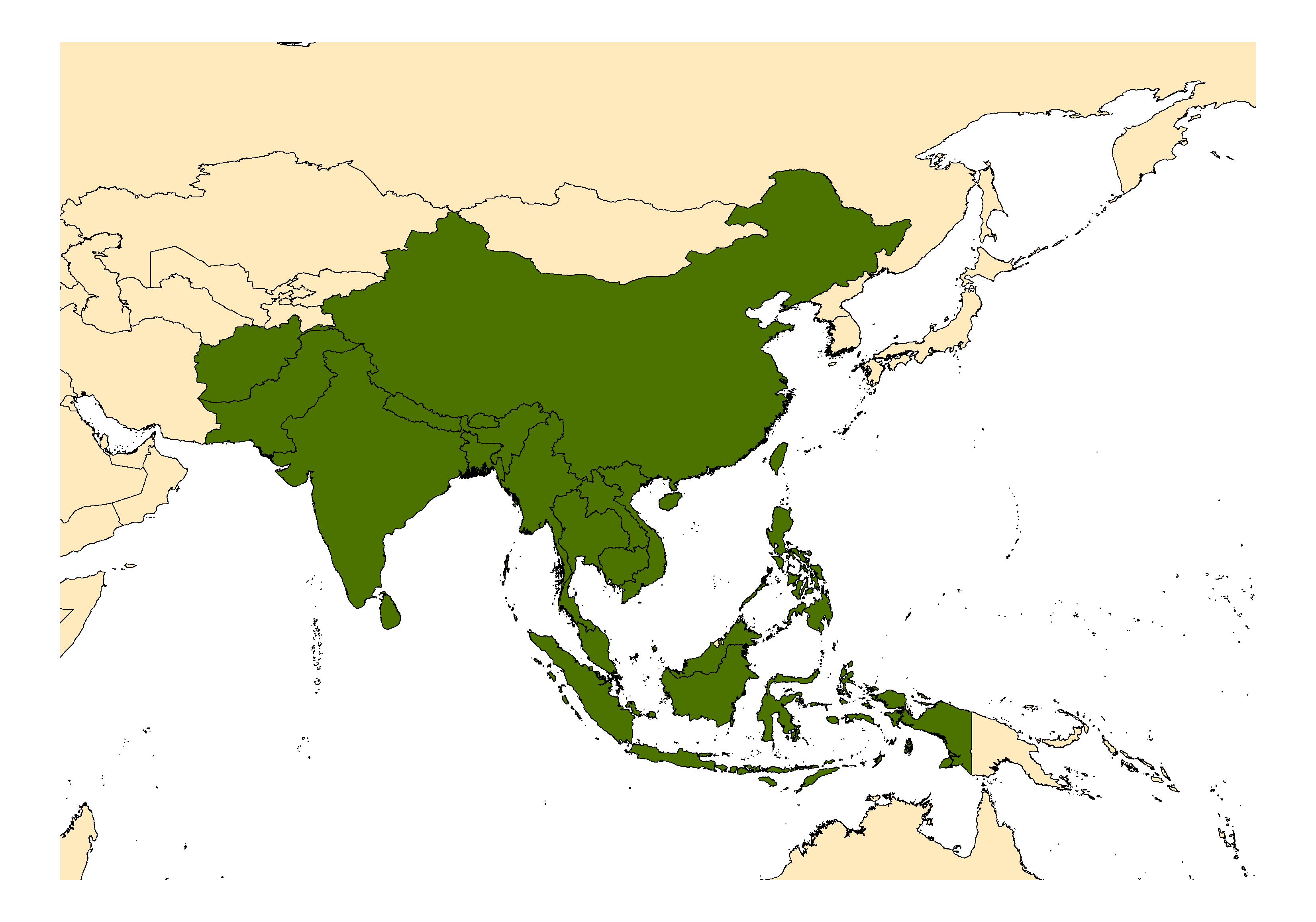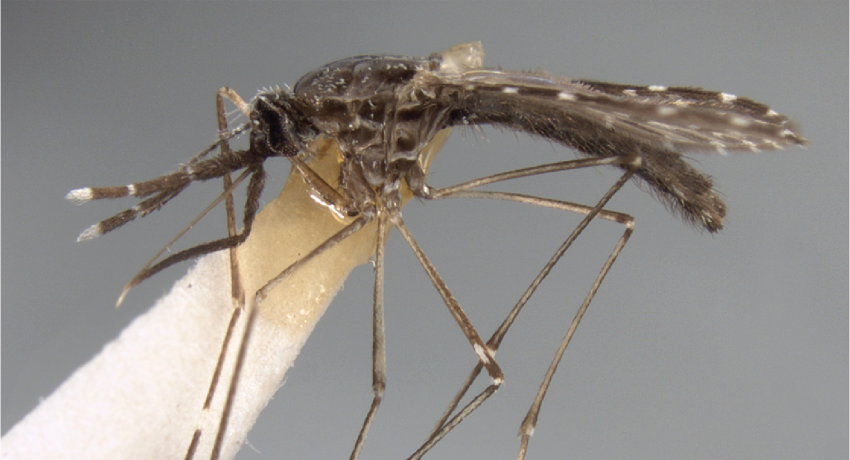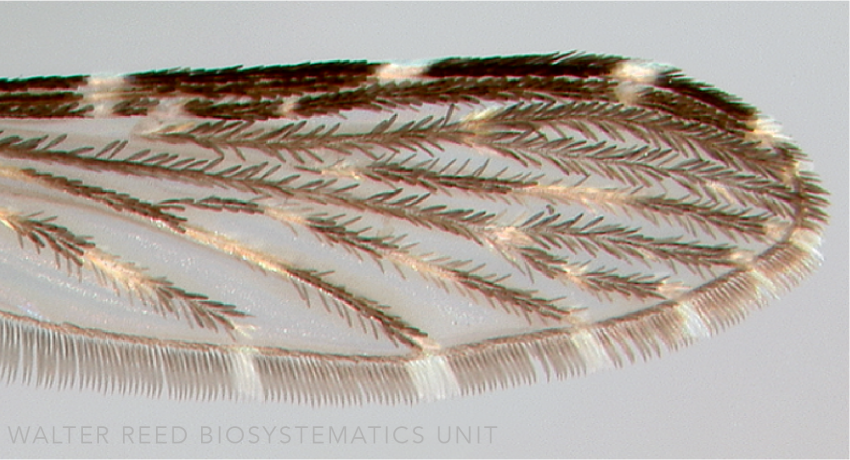INDO-ORIENTAL REGION
Etymology: ringed (L); palpi, tarsi
Anopheles annularis was originally described from Mount Ardjoeno in Java, Indonesia. It is found across the mainland and islands of southeast Asia, in the Philippines and north to Taiwan and Nepal and through to the Indian subcontinent as far west as Afghanistan and Pakistan. Cytogenetic studies conducted in India showed support for two species (A and B) characterized by +j1 and j1 arrangements in chromosome arm 2, respectively. Species A has been molecularly verified in China, India, Myanmar, Nepal, Philippines, Timor, Thailand and Sri Lanka. Species B has been detected in Sri Lanka, India, Nepal and matched to one Cambodian sample in GenBank.
Anopheles annularis is the nominotypical species of the informally designated Annularis Group and Annularis Complex. The Annularis Group comprises five species split into two species complexes: Annularis Complex (comprising An. annularis, An. pallidus Theobald, An. philippinensis Ludlow, An. schueffneri Stanton) and the Nivipes Compex (containing only An. nivipes (Theobald), which is known to comprise two cytogenetic forms). Six formerly described taxa are currently in synonomy with An. annularis: An. fuliginosus Giles, An. leucopus Dönitz, An. jamesii Liston, An. nagpori James & Liston, An. lineata Ludlow and An. adiei James & Liston. It remains unknown how species A and B correspond to topotypic populations of An. annularis, and which, if any, of these synonyms correspond to the emergent taxa in the Annulipes Complex.
Type locality: Mount Ardjoeno, Java [Indonesia]
Type depository: State Museum of Natural History, Leyden, Netherlands (LM)
DIAGNOSTIC CHARACTERS (Click photos to view; mouse over and click large photo to zoom in.)
ADULT (illustrated): Head: Frontal tuft with long, white slender scales; palpus with 3 pale bands. Thorax: Anterior promontory with erect white, slender scales; upper proepisternal setae absent. Wing: Vein CuA with more dark than pale scaling and dark spot at fork with crossvein mcu. Legs: Fe-III, Ti-III and Ta-III1 without pale speckling; Ta-III3-5 entirely white.
LARVA (not illustrated): Head: Seta 3-C multi-branched, brush-like; seta 8-C single or double. Abdomen: Seta 1-I palmate, moderately developed.
TAXONOMIC KEYS
Nguyen Thuong Hien 1968
Reid 1968
Rattanarithikul & Harrison 1973
Lee et al. 1987b
Darsie & Pradhan 1990
Rattanarithikul et al. 2006b
![]()
WRBU – Anopheles - Neocellia Series - Indomalayan Region - Adult
![]()
WRBU – Anopheles - Neocellia Series - Indomalayan Region - Larva
![]()
WRBU – Anopheles - Neocellia Series – Oriental Region - Adult
![]()
WRBU – Anopheles - Neocellia Series – Oriental Region - Larva
![]()
WRBU - Anopheles - Western Palearctic Region - Adult
![]()
WRBU - Genera - Global - Adult
![]()
WRBU - Genera - Global - Larva
![]()
WRBU - Anopheles Subgenera and Series - Indomalaya - Adult
![]()
WRBU - Anopheles Subgenera and Series - Indomalaya - Larva
![]()
WRBU - Anopheles Subgenera and Series - Oriental - Adult
![]()
WRBU - Anopheles Subgenera and Series - Oriental - Larva
Exemplar DNA sequences
An. annularis Species A - ITS2: (DQ351853 (India), FJ526607 (Sri Lanka), FJ526609 (Myanmar), FJ526613 (Philippines), EU919720 (China), FJ526615 (Thailand), GU062187 (Timor); Species B – ITS2: (DQ351854, India).
BIONOMICS
Immatures
Typically, An. annularis s.l. immatures are collected in large, fresh water sites including lakes, ponds, rice fields, ditches and swamps with plentiful aquatic vegetation, but have also been collected from large artificial water tanks. In northern India, the species overwinters both as adults and larvae.
Adults
The roles of An. annularis s.l. populations in malaria transmission are highly variable Low numbers of naturally-infected An. annularis s.l. have been reported in China, Malaysia, Myanmar, the Philippines, and Thai-Cambodian border region. In Yunnan, China, An. annularis s.l. feeds on man in high numbers throughout the night. In Malaysia, An. annularis s.l. is regarded as zoophilic, rarely biting man. In Bengal, India, An. annularis s.l. are anthropophilic and zoophilic, and rest both in houses and in stables. in India, only species A has been implicated in malaria transmission.
DISTRIBUTION NOTES
Afghanistan, Bangladesh, Bhutan, Cambodia, India, Indonesia (Java, Flores, Kalimantan, Moluccas, Sulawesi, Sumatra includes Ketulauan Riouw Archipelago, Timor), Malaysia, Myanmar, Nepal, Pakistan, People's Republic of China, Philippines, Sri Lanka, Taiwan, Thailand, Timor, Vietnam

WRBU VECTOR HAZARD REPORTS
View other WRBU Vector Hazard Reports
Available GIS Models:
IMPORTANT REFERENCES (full citations below)
Van der Wulp 1884: 249 (F)
Christophers 1933: 300 (M*, F*, P, L*, E)
Ross & Roberts 1943b: 31 (M*, F*, L*; taxonomy, distribution, bionomics)
Bonne-Wepster & Swellengrebel 1953: 438 (M*, F*, L*)
Horsfall 1955: 193 (review)
Hara 1959: 110 (F*)
Nguyen Thuong Hien 1968 (F*, L*; keys, taxonomy, bionomics, Vietnam)
Reid 1968: 373 (M*, F*, P*, L*, E*; keys, taxonomy)
Basio 1971b: 38 (M*, F*; bionomics)
Rattanarithikul & Harrison 1973 (L*; key, distribution; Thailand)
Ameen & Talukdar 1974c: 90 (P*)
Baisas 1974: 56 (M, F*, P, L*; taxonomy, bionomics, distribution; Philippines)
Dash et al. 1983 (morphology; taxonomy; sensu lato)
Ahmed 1987 (distribution; Bangladesh)
Lee et al. 1987b: 129 (F key, taxonomy, bionomics, distribution, review)
Darsie & Pradhan 1990 (F, L; taxonomy, keys, bionomics, distribution; Nepal)
Suleman et al. 1993 (distribution; Pakistan)
Atrie et al. 1999 (sensu lato; chromosomes)
Whelan & Hapgood 2000 (bionomics, distribution; East Timor)
Rattanarithikul et al. 2006b (F*, L*; bionomics, distribution, keys)
Alam et al. 2007 (sensu lato; molecular taxonomy)
Rueda et al. 2008 (distribution)
Surendran et al. 2013 (molecular taxonomy; distribution: Sri Lanka; sensu lato)
Sinka et al. 2011: 89 (bionomics review, distribution, niche model)
Namgay et al. 2018 (distribution, bionomics; Bhutan)
CURRENT SYNONYMS
syn. fuliginosus Giles
1900a: 161 (F*). Type locality: Calcutta [West Bengal], India (NHMUK). References: Christophers & Barraud 1931: 177 (E*); Senevet 1931: 62 (P*); Townsend 1990: 76 (type information).
syn. leucopus Dönitz
1901: 37 (M, F). Type locality: Doerian [Palembang], Sumatra [Indonesia] (ZM).
syn. jamesii Liston
1901: 441 (A; not Theobald, 1901a). Type locality: Ellichpur [Central Provinces], India (LU).
syn. lineata Ludlow
1908a: 50 (A; Chagasia?). Type locality: Camp Gregg, Pangasinan, Luzon, Philippines (USNM).
syn. nagpori James & Liston
1911: 90 (A; Nyssorhynchus fuliginosus var.). Type locality: Nagpur [Central Provinces], India (LU).
syn. adiei James & Liston
1911: 89 (A; Nyssorhynchus fuliginosus var.). Type locality: Ferozepore & Amritsar, Punjab [Hill States], India (LU). References: Christophers 1933: 300 (synonymy; melanic variation).
CITED REFERENCES
Ahmed, T.U. (1987). Checklist of the mosquitoes of Bangladesh. Mosquito Systematics, 19(3), 187–200.
Alam, M.T., Das, M.K., Dev, V., Ansari, M.A., & Sharma, Y.D. (2007). Identification of two cryptic species in the Anopheles (Cellia) annularis complex using ribosomal DNA PCR-RFLP. Parasitology Research, 100(5), 943–948.
Ameen, M.-U., & Talukdar, M.Z.I. (1974c). Pupal chaetotaxy of the common mosquitoes of Dacca. Beiträge zur Entomologie, 24(1,4), 87–95.
Atrie, B., Subbarao, S. K., Pillai, M. K. K., Rao, S. R. V., & Sharma, V. P. (1999). Population cytogenetic evidence for sibling species in Anopheles annularis (Diptera: Culicidae). Annals of the Entomological Society of America, 92(2), 243–249.
Baisas, F. E. (1974). The mosquito fauna of Subic Bay Naval Reservation, Republic of the Philippines. San Francisco: Headquarters, First Medical Service Wing (PACAF), San Francisco.
Basio, R. G. (1971b). The mosquito fauna of the Philippines (Diptera, Culicidae). Manila: National Museum of the Philippines. 198pp.
Bonne-Wepster, J., & Swellengrebel, N.H. (1953). The anopheline mosquitoes of the Indo-Australian Region. Amsterdam: J. H. de Bussy.
Christophers, S.R. (1933). The fauna of British India, including Ceylon and Burma. Diptera.Vol. IV. Family Culicidae. Tribe Anophelini. London: Taylor and Francis.
Christophers, S.R., & Barraud, P.J. (1931). The eggs of Indian Anopheles, with descriptions of the hitherto undescribed eggs of a number of species. Records of the Malaria Survey of India, 2(1), 161–192.
Darsie, R.F., Jr., & Pradhan, S.P. (1990). The mosquitoes of Nepal: Their identification, distribution and biology. Mosquito Systematics, 22(2), 69–130.
Dash, A.P., Khamre, J.S., Roy, J.R., Bendle, M.S., Das, M., & Dwived, S.R. (1983). Morphometrical variations in Anopheles annularis. Journal of Communicable Diseases, 15(1), 61–64.
Dönitz, W. (1901). Nachrichten aus dem Berliner Entomologischen Verein. Insekten -Borse, 18, 36–38.
Giles, G. M. (1900a). A handbook of the gnats or mosquitoes giving the anatomy and life history of the Culicidae. J Bale and Sons and Danielsson, Ltd London.
Hara, J. (1959). Taxonomical notes on the female terminalia of some anopheline mosquitoes of Japan and Formosa. Taxonomic and ecological studies on mosquitoes of Japan (Part 12). Japanese Journal of Experimental Medicine, 29, 107–119.
Horsfall, W.R. (1955). Mosquitoes. Their bionomics and relation to disease. New York, NY: Hafner Publishing Company. (Reprinted 1972).
James, S.P., & Liston, W.G. (1911). A monograph of the anopheline mosquitoes of India, 2nd edition. Calcutta: Thacker, Spink and Co.
Lee, D.J., Hicks, M.M., Griffiths, M., Debenham, M.L., Bryan, J.H., Russell, R.C., . . . Marks, E.N. (1987b). The Culicidae of the Australasian region. Volume 5. Commonwealth Department of Health, School of Public Health and Tropical Medicine Monograph Series, 2.
Liston, W.G. (1901). A year's experience of the habits of Anopheles in Ellichpur. The description of the species of Anopheles found in Ellichpur during the year. Indian Medical Gazette, 36, 361–366, 441–443.
Ludlow, C.S. (1908a). Mosquito notes. VI. Canadian Entomologist, 40, 32–34, 50–52, 331–332.
Namgay, R., Drukpa, T., Wangdi, T., Pemo, D., Harbach, R.E., & Somboon, P. (2018). A checklist of the Anopheles mosquito species (Diptera: Culicidae) in Bhutan. Acta Tropica 188 (2018) 206–212.
Nguyen Thuong Hien (1968). The genus of Anopheles in Vietnam. Saigon: Bureau of Entomology, National Malaria Program/ Republic of Vietnam. English translation by Military Entomology Information Service. 205pp.
Rattanarithikul, R., & Harrison, B.A. (1973). An illustrated key to the Anopheles larvae of Thailand. U S Army Medical Component, SEATO, Bangkok, Thailand.
Rattanarithikul, R., Harrison, B.A., Harbach, R.E., Panthusiri, P., & Coleman, R.E. (2006b). Illustrated keys to the mosquitoes of Thailand. IV. Anopheles. Southeast Asian Journal of Tropical Medicine and Public Health, 128(Supplement 2), 2.
Reid, J.A. (1968). Anopheline mosquitoes of Malaya and Borneo. Studies from the Institute for Medical Research Malaysia, 31, 1–520.
Ross, E.S., & Roberts, H.R. (1943b). Mosquito atlas. Part II. Eighteen old world anophelines important to malaria. Contributions of the American Entomological Institute.
Rueda, L.M., J.E. Pecor, J., Lowen., R. G., & Carder, M. (2008). New record and updated checklist of the mosquitoes of Afghanistan and Iraq. Journal of Vector Ecology, 3(2), 397–402.
Sinka, M.E., Bangs, M.J., Manguin, S., Chareonviriyaphap, T., Patil, A.P., Temperley, W.H., ... Hay, S.I. (2011). The dominant Anopheles vectors of human malaria in the Asia-Pacific region: Occurrence data, distribution maps and bionomic précis. Parasites & Vectors, 4(1), 89.
Suleman, M., Khan, K., & Khan, S. (1993). Ecology of mosquitoes in Peshawar Valley and adjoining areas: Species composition and relative abundance. Pakistan Journal of Zoology, 25(4), 321–328.
Surendran, S.N., Sarma, D.K., Jude, P.J., Kemppainen, P., Kanthakumaran, N., Gajapathy, K., . . . Walton, C. (2013). Molecular characterization and identification of members of the Anopheles subpictus complex in Sri Lanka. Malaria Journal, 12, 304.
Whelan, P., & Hapgood, G. (2000). A mosquito survey of Dili, East Timor, and implications for disease control. Arbovirus Research in Australia, 8, 405–416.
CITE THIS PAGE
Walter Reed Biosystematics Unit (Year). Anopheles annularis species page. Walter Reed Biosystematics Unit Website, http://wrbu.si.edu/vectorspecies/mosquitoes/annularis, accessed on [date (e.g. 03 February 2020) when you last viewed the site].










































































































































































